ABS FIAT DUCATO 2014 Owner handbook (in English)
[x] Cancel search | Manufacturer: FIAT, Model Year: 2014, Model line: DUCATO, Model: FIAT DUCATO 2014Pages: 367, PDF Size: 20.39 MB
Page 223 of 367
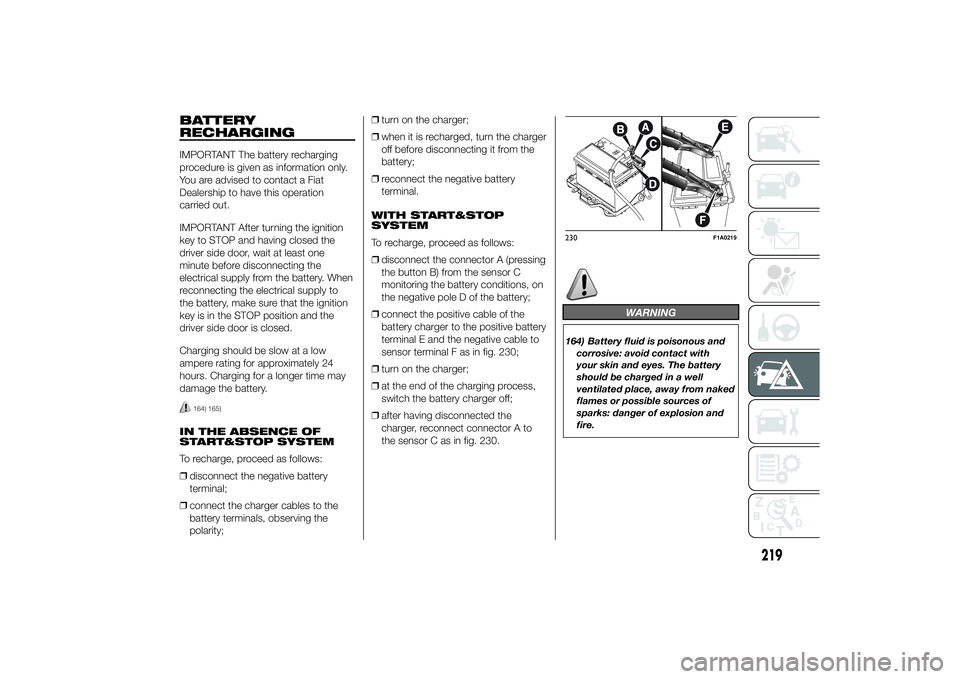
BATTERY
RECHARGINGIMPORTANT The battery recharging
procedure is given as information only.
You are advised to contact a Fiat
Dealership to have this operation
carried out.
IMPORTANT After turning the ignition
key to STOP and having closed the
driver side door, wait at least one
minute before disconnecting the
electrical supply from the battery. When
reconnecting the electrical supply to
the battery, make sure that the ignition
key is in the STOP position and the
driver side door is closed.
Charging should be slow at a low
ampere rating for approximately 24
hours. Charging for a longer time may
damage the battery.
164) 165)
IN THE ABSENCE OF
START&STOP SYSTEM
To recharge, proceed as follows:
❒disconnect the negative battery
terminal;
❒connect the charger cables to the
battery terminals, observing the
polarity;❒turn on the charger;
❒when it is recharged, turn the charger
off before disconnecting it from the
battery;
❒reconnect the negative battery
terminal.
WITH START&STOP
SYSTEM
To recharge, proceed as follows:
❒disconnect the connector A (pressing
the button B) from the sensor C
monitoring the battery conditions, on
the negative pole D of the battery;
❒connect the positive cable of the
battery charger to the positive battery
terminal E and the negative cable to
sensor terminal F as in fig. 230;
❒turn on the charger;
❒at the end of the charging process,
switch the battery charger off;
❒after having disconnected the
charger, reconnect connector A to
the sensor C as in fig. 230.
WARNING
164) Battery fluid is poisonous and
corrosive: avoid contact with
your skin and eyes. The battery
should be charged in a well
ventilated place, away from naked
flames or possible sources of
sparks: danger of explosion and
fire.230
F1A0219
219
Page 225 of 367
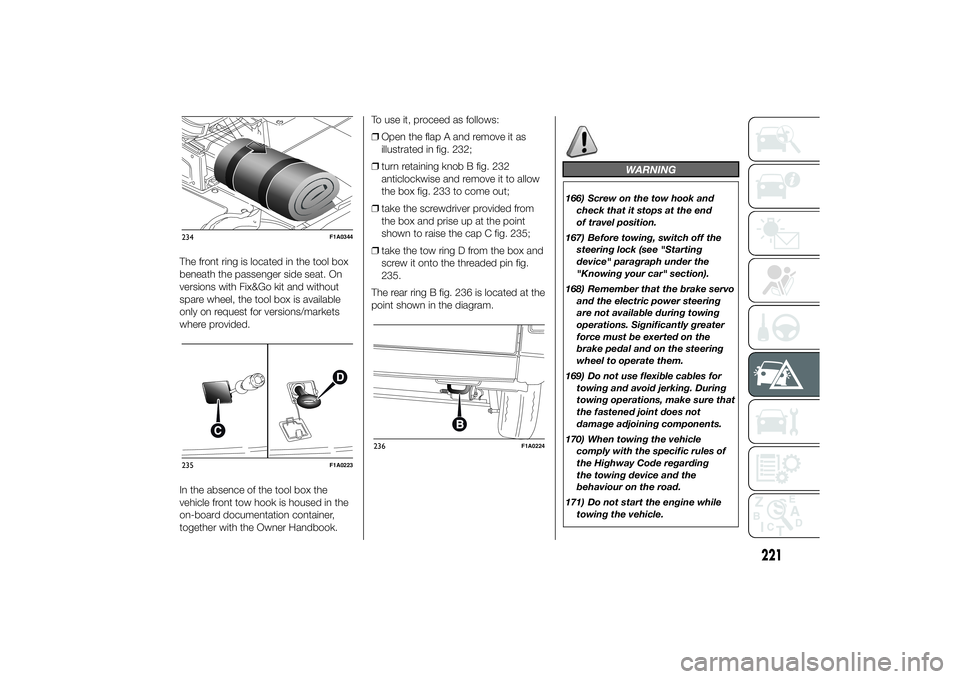
The front ring is located in the tool box
beneath the passenger side seat. On
versions with Fix&Go kit and without
spare wheel, the tool box is available
only on request for versions/markets
where provided.
In the absence of the tool box the
vehicle front tow hook is housed in the
on-board documentation container,
together with the Owner Handbook.To use it, proceed as follows:
❒Open the flap A and remove it as
illustrated in fig. 232;
❒turn retaining knob B fig. 232
anticlockwise and remove it to allow
the box fig. 233 to come out;
❒take the screwdriver provided from
the box and prise up at the point
shown to raise the cap C fig. 235;
❒take the tow ring D from the box and
screw it onto the threaded pin fig.
235.
The rear ring B fig. 236 is located at the
point shown in the diagram.
WARNING
166) Screw on the tow hook and
check that it stops at the end
of travel position.
167) Before towing, switch off the
steering lock (see "Starting
device" paragraph under the
"Knowing your car" section).
168) Remember that the brake servo
and the electric power steering
are not available during towing
operations. Significantly greater
force must be exerted on the
brake pedal and on the steering
wheel to operate them.
169) Do not use flexible cables for
towing and avoid jerking. During
towing operations, make sure that
the fastened joint does not
damage adjoining components.
170) When towing the vehicle
comply with the specific rules of
the Highway Code regarding
the towing device and the
behaviour on the road.
171) Do not start the engine while
towing the vehicle.
234
F1A0344
235
F1A0223
236
F1A0224
221
Page 238 of 367
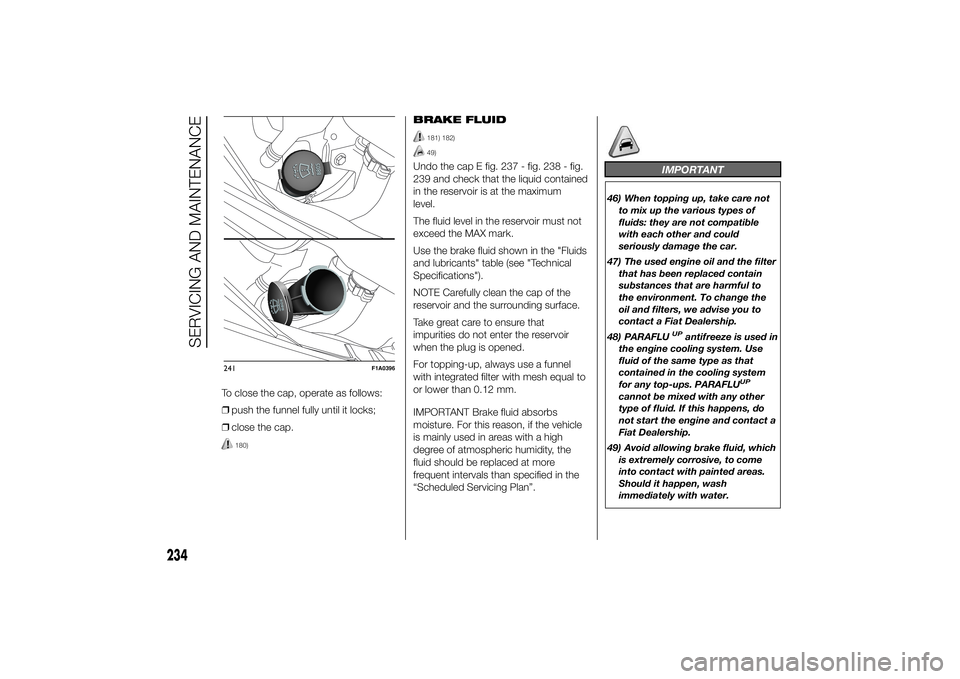
To close the cap, operate as follows:
❒push the funnel fully until it locks;
❒close the cap.
180)
BRAKE FLUID
181) 182)49)
Undo the cap E fig. 237 - fig. 238 - fig.
239 and check that the liquid contained
in the reservoir is at the maximum
level.
The fluid level in the reservoir must not
exceed the MAX mark.
Use the brake fluid shown in the "Fluids
and lubricants" table (see "Technical
Specifications").
NOTE Carefully clean the cap of the
reservoir and the surrounding surface.
Take great care to ensure that
impurities do not enter the reservoir
when the plug is opened.
For topping-up, always use a funnel
with integrated filter with mesh equal to
or lower than 0.12 mm.
IMPORTANT Brake fluid absorbs
moisture. For this reason, if the vehicle
is mainly used in areas with a high
degree of atmospheric humidity, the
fluid should be replaced at more
frequent intervals than specified in the
“Scheduled Servicing Plan”.
IMPORTANT
46) When topping up, take care not
to mix up the various types of
fluids: they are not compatible
with each other and could
seriously damage the car.
47) The used engine oil and the filter
that has been replaced contain
substances that are harmful to
the environment. To change the
oil and filters, we advise you to
contact a Fiat Dealership.
48) PARAFLU
UP
antifreeze is used in
the engine cooling system. Use
fluid of the same type as that
contained in the cooling system
for any top-ups. PARAFLU
UP
cannot be mixed with any other
type of fluid. If this happens, do
not start the engine and contact a
Fiat Dealership.
49) Avoid allowing brake fluid, which
is extremely corrosive, to come
into contact with painted areas.
Should it happen, wash
immediately with water.
241
F1A0396
234
SERVICING AND MAINTENANCE
Page 321 of 367
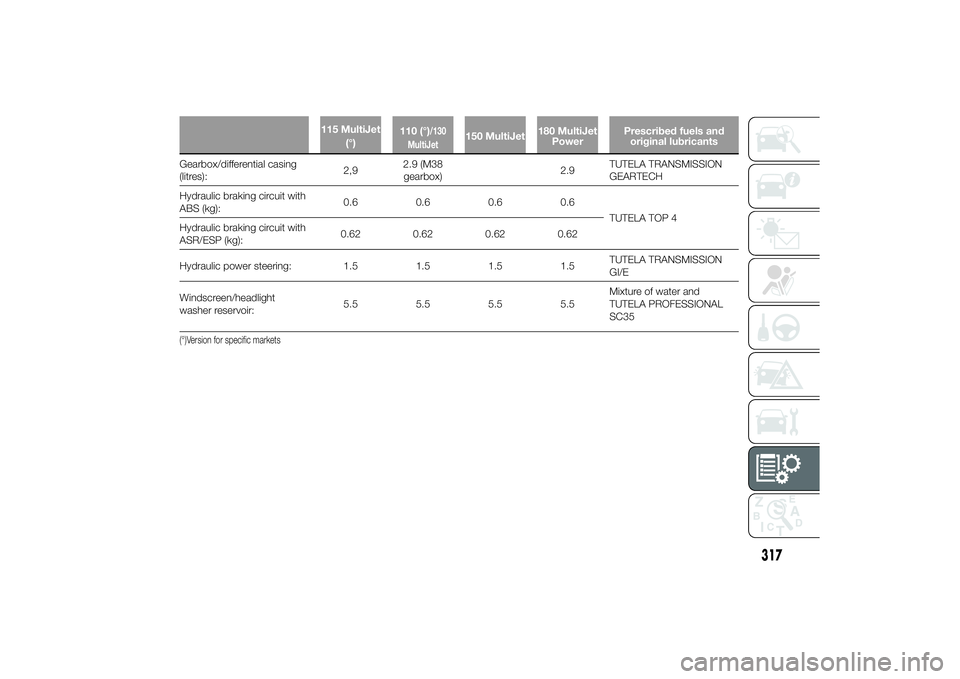
115 MultiJet
(°)110 (°)
/130
MultiJet
150 MultiJet180 MultiJet
PowerPrescribed fuels and
original lubricants
Gearbox/differential casing
(litres):2,92.9 (M38
gearbox)2.9TUTELA TRANSMISSION
GEARTECH
Hydraulic braking circuit with
ABS (kg):0.6 0.6 0.6 0.6
TUTELA TOP 4
Hydraulic braking circuit with
ASR/ESP (kg):0.62 0.62 0.62 0.62
Hydraulic power steering: 1.5 1.5 1.5 1.5TUTELA TRANSMISSION
GI/E
Windscreen/headlight
washer reservoir:5.5 5.5 5.5 5.5Mixture of water and
TUTELA PROFESSIONAL
SC35(°)Version for specific markets
317
Page 363 of 367
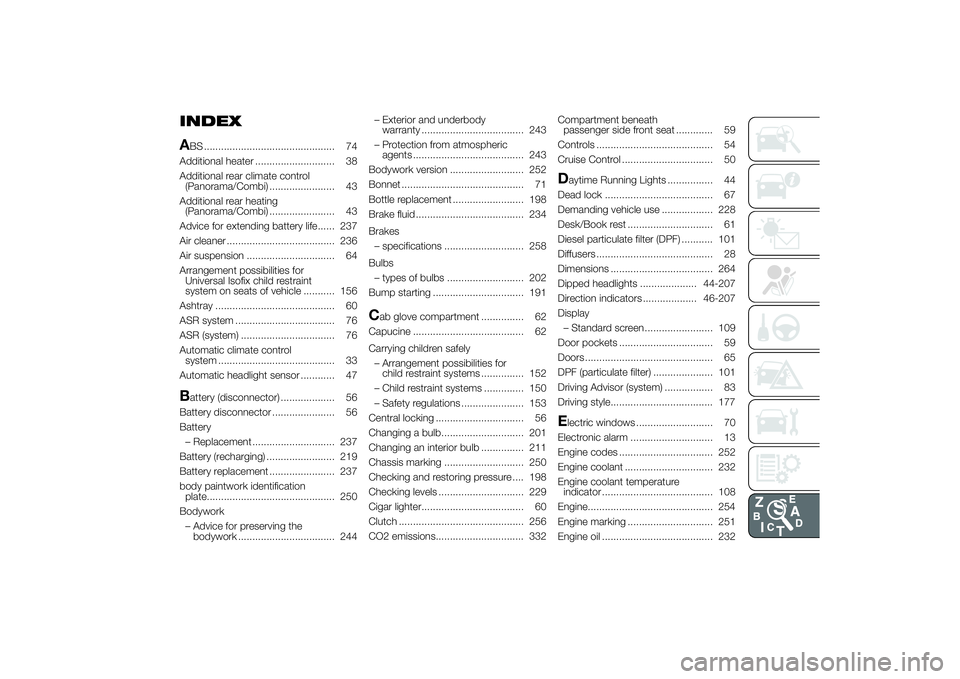
INDEX
ABS .............................................. 74
Additional heater ............................ 38
Additional rear climate control
(Panorama/Combi) ....................... 43
Additional rear heating
(Panorama/Combi) ....................... 43
Advice for extending battery life...... 237
Air cleaner ...................................... 236
Air suspension ............................... 64
Arrangement possibilities for
Universal Isofix child restraint
system on seats of vehicle ........... 156
Ashtray .......................................... 60
ASR system ................................... 76
ASR (system) ................................. 76
Automatic climate control
system ......................................... 33
Automatic headlight sensor ............ 47Battery (disconnector) ................... 56
Battery disconnector ...................... 56
Battery
– Replacement ............................. 237
Battery (recharging) ........................ 219
Battery replacement ....................... 237
body paintwork identification
plate............................................. 250
Bodywork
– Advice for preserving the
bodywork .................................. 244– Exterior and underbody
warranty .................................... 243
– Protection from atmospheric
agents ....................................... 243
Bodywork version .......................... 252
Bonnet ........................................... 71
Bottle replacement ......................... 198
Brake fluid ...................................... 234
Brakes
– specifications ............................ 258
Bulbs
– types of bulbs ........................... 202
Bump starting ................................ 191
Cab glove compartment ............... 62
Capucine ....................................... 62
Carrying children safely
– Arrangement possibilities for
child restraint systems ............... 152
– Child restraint systems .............. 150
– Safety regulations ...................... 153
Central locking ............................... 56
Changing a bulb............................. 201
Changing an interior bulb ............... 211
Chassis marking ............................ 250
Checking and restoring pressure .... 198
Checking levels .............................. 229
Cigar lighter.................................... 60
Clutch ............................................ 256
CO2 emissions............................... 332Compartment beneath
passenger side front seat ............. 59
Controls ......................................... 54
Cruise Control ................................ 50
Daytime Running Lights ................ 44
Dead lock ...................................... 67
Demanding vehicle use .................. 228
Desk/Book rest .............................. 61
Diesel particulate filter (DPF) ........... 101
Diffusers ......................................... 28
Dimensions .................................... 264
Dipped headlights .................... 44-207
Direction indicators ................... 46-207
Display
– Standard screen ........................ 109
Door pockets ................................. 59
Doors ............................................. 65
DPF (particulate filter) ..................... 101
Driving Advisor (system) ................. 83
Driving style.................................... 177Electric windows ........................... 70
Electronic alarm ............................. 13
Engine codes ................................. 252
Engine coolant ............................... 232
Engine coolant temperature
indicator ....................................... 108
Engine............................................ 254
Engine marking .............................. 251
Engine oil ....................................... 232